The chimney is used to remove a mixture of gases with fuel combustion products from the furnace. When it becomes clogged, the process of removing harmful substances is disrupted. Small debris falling through the pipe can lead to malfunction. To secure the structure, special visors for the chimney are used. They come in different designs and may have an original design. You can create a cap on a pipe by yourself using existing drawings.
Cap construction

A chimney visor is a special device that is placed on the chimney to protect it from moisture, foliage, birds and other objects. Umbrellas come in many variations in appearance, size and design. But the main elements, regardless of the type, are:
- Protective umbrella for the chimney. It can be in the form of a cone, pyramid, semicircle, or other geometric shape. The device serves to protect the pipe.
- Dropper apron. It protects the chimney from droplets that bounce off the umbrella. Helps to protect the device from corrosion, mold and mildew, thereby extending its life. Suitable for rectangular umbrellas.
- Brackets. These are the metal plates that connect the visor and apron. The fastening itself is carried out by welding.
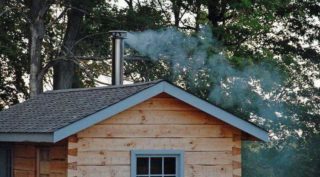
The main types of protective elements for the pipe:
- Cap. This is the name of a tin plate that overlaps the cross-section of the pipe, protecting it from precipitation. In this case, the smoke channel remains open.
- Umbrella. This is a cap with additional construction on it. The name is derived from its conical shape. It protects the pipe from precipitation and ensures efficient removal of combustion products.
- Weathervane. Unlike an umbrella, it also regulates traction. Able to rotate from gusts of wind. The smoke is discharged from it along the axis, and from the umbrella - by 360 °. It is installed on complex roofs with a high probability of oncoming air currents.
- Deflector. It is a device whose main purpose is to improve traction caused by improper mounting or placement. Also protects the pipe from precipitation, birds and debris.
To create a visor with your own hands, use sheet metal that does not corrode. It can be galvanized steel, aluminum, copper.
Varieties of visors

A wide range of shapes and sizes of chimneys forces manufacturers to create different types of canopies. The most common types are:
- Standard weather vane. This is a classic pyramid umbrella made of sheet metal and fixed with brackets.
- Four-slope weather vane. The top is a hipped roof. Usually used for rectangular brick pipes.
- Semicircular umbrella. Used for installation on European style roofs. Has low traction.
- Flat weather vane. Due to the flat roof, the snow does not roll down, so there is an increased load on the brackets. There is a risk of deformation.
- Round vane with a cone. Suitable for pipes with a circular cross section. Does not have a drip.
The weather vane has additional elements that expand the functionality: these are dampers, double roofs, hinged doors. But if you create a cap on the chimney with your own hands, it is better to limit the use of additional components so as not to complicate the design and not to reduce the efficiency of the system.
Pros and cons
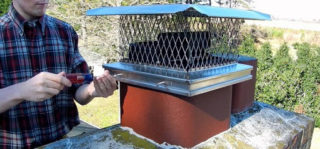
In addition to protecting the chimney from external objects and atmospheric precipitation, the hood affects the draft force. The air moves along the pipe horizontally or at an angle, then separates and goes down. As a result, a low pressure zone is created, where smoke from the furnace tends to get.
The main functions of the protective deflector:
- Protection against the ingress of foreign objects into the pipe. It can be branches, foliage, birds, garbage. Thanks to the protective cover, the chimney will become less clogged and will last longer.
- Protection from moisture, snow, precipitation. Due to the appearance of dampness in the pipe, favorable conditions will be created for the growth and spread of the fungus.
- Optimization of the chimney. In the case of a correctly chosen design, the efficiency of the pipe can be increased by 10-15%.
- Additional ventilation of the room.
- Decor. The product can decorate the roof and become an accent in the design of the house.
The appearance of the device is not the main selection criterion. A properly selected hood should not generate noise and vibration, and also cause backdraft.
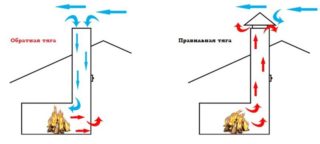
The main task of the hood is obvious - to protect the chimney. But there are arguments against installing a visor on a pipe:
- Risk of obstruction of smoke and combustion products outlet. An existing obstruction in the form of a roof will impede the efficient removal of contaminated airflow.
- Risk of reduced thrust.
- In winter, ice can form on the visor, due to which combustion products will return to the room and poison the air.
With the correct selection of caps, all the disadvantages will be eliminated. It is important to make a cap on the chimney with your own hands according to the instructions, and then correctly install the visor according to SNiP and safety regulations.
The chimney umbrella is not an eternal design. Even a device made of durable, reliable material will lose its effectiveness over time. High temperatures and acidic components contained in combustion products, which destroy the metal, are especially affected. Therefore, every few years it will be necessary to replace the pipe nozzle.
DIY visor creation
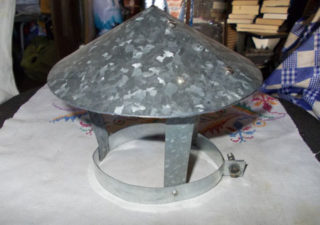
During the installation and creation of the hood, the following errors may occur:
- Incorrect measurements. Then the cap will fall into the cavity of the chimney and block the outlet of combustion products.
- The use of substandard materials. The pipe nozzle will quickly become rusty, which will significantly reduce its service life.
- Choosing a rotating model in a region with cold and snowy winters. Snow can blow in the appliance, causing it to stop rotating and disrupting the smoke extraction from the house.
To avoid these problems, you need to follow the instructions for creating and carefully take measurements from the chimney.
The process of creating a visor is straightforward. It is recommended to choose the simplest model of an umbrella for the chimney, otherwise a larger number of calculations will be required, which are difficult to make yourself without the help of specialists.
For work, you need to prepare materials and tools. You will need sheet metal (it is better to take galvanized steel), a hacksaw for metal, bends, a welding machine, a marker, a ruler and cardboard.
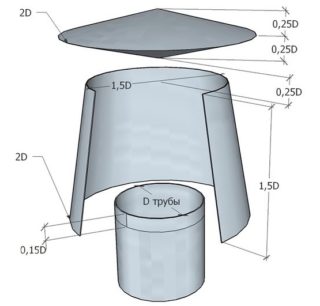
Algorithm for creating a cap on a chimney pipe with your own hands:
- Chimney measurements.
- Creation of a pattern of a fungus for a chimney on cardboard. According to pre-calculated measurements, the outline of the future cap is drawn with an indent of 4-5 mm.
- Transferring the drawing to metal.
- Cutting out the workpiece.
- The fold lines marked on the workpiece must be bent. Where the joints are located, make 3 holes with a pitch of 15-20 mm and fix the visor with rivets.
- Transferring the pattern of the dropper apron to the metal sheet. Creation of folds using a bending machine. Connecting parts with rivets.
- Creation of brackets from metal plates. Welding them to the umbrella and apron. Processing of welding places with a metal primer.
- Application of anti-corrosion protection to the structure in several layers.
A homemade chimney umbrella should dry within 1-2 days, after which it can be used.
Selection recommendations
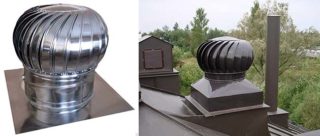
The safety of the room and the efficiency of the pipe depend on the choice of a suitable model. The main criterion is the type of boiler plant and the type of fuel on which it operates.
Brick stoves with a chimney having a rectangular cross-section, a special hood is suitable - a deflector. Dangerous eddy effects can occur in pipes of this type, which negatively affects traction. Also, soot, soot and dust settle on the rough surfaces of brick pipes, which also negatively affect the extraction of smoke. Thanks to the installation of a deflector, excess dirt will not enter the pipe, and moisture evaporation will not increase the adhesion of combustion products. An important factor is the timely cleaning of the chimney.
If a solid fuel boiler with a ceramic pipe or a sandwich pipe flue is used, the problem of soot formation on the walls is significantly reduced. The draft directly depends on the height of the chimney. It is required to create a forced draft, otherwise it is necessary to make a pipe up to eight meters high. Thanks to the deflector, the height can be reduced by 20%, and installation is less labor intensive.
If the boiler works on the principle of pyrolysis, it is better to put a visor with an open nozzle. Then the channel will be protected from debris and rain, but at the same time it will not be an obstacle to the release of low temperature smoke.








